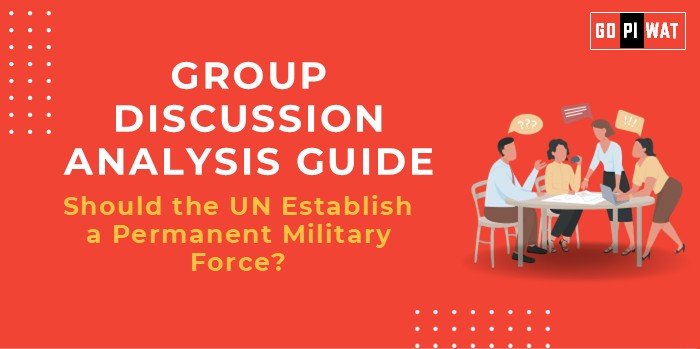📋 Group Discussion Analysis Guide
🌐 Should the United Nations Have a Permanent Military Force?
📖 Introduction to the Topic
Context: The concept of a United Nations (UN) permanent military force often surfaces in discussions about global peace and security. With conflicts like the Syrian Civil War and the ongoing Russia-Ukraine crisis highlighting limitations in peacekeeping operations, this proposal has renewed urgency.
Background: Founded in 1945, the UN’s primary goal is maintaining global peace. While it has deployed peacekeepers in various regions, the lack of a permanent military force limits its capacity for rapid response and strategic interventions. Recent calls for reform echo similar discussions that have taken place since the 1950s.
📊 Quick Facts and Key Statistics
- 🌍 Current Peacekeepers: Over 87,000 personnel from 121 countries deployed across 12 active missions (UN, 2023).
- 💰 Budget for Peacekeeping (2023): $6.5 billion, constituting 0.5% of global military spending.
- 📉 Member Contribution Delays: 36% of assessed contributions unpaid in 2023.
- ⏳ Conflict Duration: Average duration of modern conflicts has doubled since 1990, emphasizing the need for quicker interventions.
🌟 Stakeholders and Their Roles
- 🏛️ United Nations Security Council (UNSC): Authorizes peacekeeping missions and sanctions military interventions.
- 🌐 Member States: Provide voluntary troops and funding. Key contributors include India, Bangladesh, and Rwanda.
- 🌍 Conflict-Affected Nations: Seek UN intervention to stabilize regions.
- 🤝 International NGOs: Collaborate on post-conflict rebuilding and monitoring.
🏆 Achievements and Challenges
✨ Achievements
- ✅ Rapid Deployment Model: Success in Liberia (2003) and Sierra Leone (1999) brought peace after long conflicts.
- 🤝 Multilateral Engagement: Peacekeeping fosters international collaboration.
⚠️ Challenges
- 💸 Resource Constraints: Dependence on voluntary contributions slows response time.
- ⚔️ Geopolitical Interference: UNSC veto power often hampers consensus.
- 📘 Global Comparisons:
– Success: NATO’s faster deployment due to centralized command structures.
– Failure: UN’s delayed response in Rwanda (1994) led to significant criticism of its peacekeeping model.
💬 Structured Arguments for Discussion
- ✅ Supporting Stance: “A permanent military force would enable faster responses, saving lives in conflicts like those in Sudan.”
- ❌ Opposing Stance: “Concentrated power in a permanent force could threaten national sovereignty and exacerbate geopolitical tensions.”
- ⚖️ Balanced Perspective: “While rapid response is critical, mechanisms to ensure neutrality and accountability are equally vital.”
💡 Effective Discussion Approaches
- 🌏 Opening Approaches:
- “The failure to prevent the Rwandan Genocide is a stark reminder of the UN’s operational gaps…”
- “With peacekeepers dependent on voluntary contributions, over 80% of missions face initial delays…”
- 🤔 Counter-Argument Handling:
- Rebut sovereignty concerns by emphasizing multilateral oversight.
- Highlight cost-sharing models to address funding concerns.
🔍 Strategic Analysis of Strengths and Weaknesses
- 💪 Strengths: Global legitimacy; experience in conflict zones.
- ⚖️ Weaknesses: Bureaucracy; dependence on member states.
- 📈 Opportunities: Leveraging technology; partnerships with regional bodies like the African Union.
- ⚠️ Threats: Political gridlock; misuse by powerful nations.
🎓 Connecting with B-School Applications
- 🌍 Real-World Applications: Policy design for global governance; resource allocation in international organizations.
- 💬 Sample Interview Questions:
- “How can a permanent military force balance sovereignty and global security?”
- “What lessons can be learned from NATO’s rapid response model?”
- 💡 Insights for Students:
- Consider stakeholder management, conflict resolution frameworks, and resource optimization in global governance.


